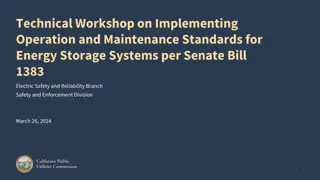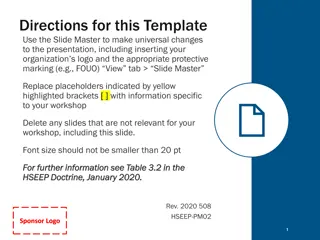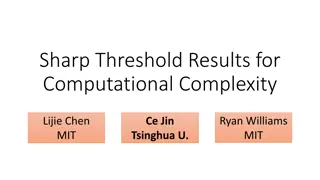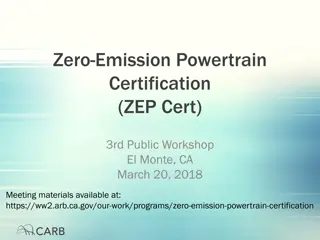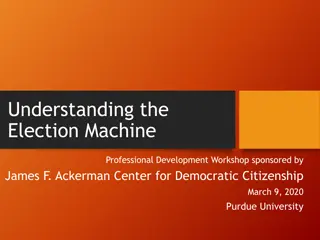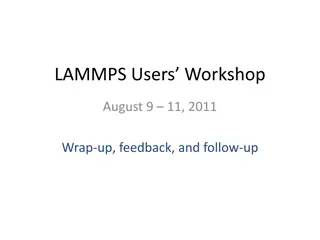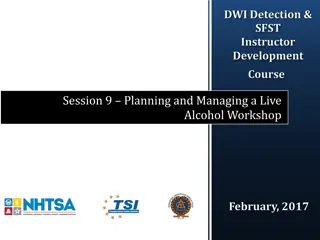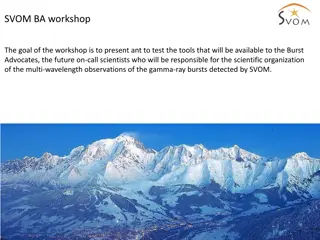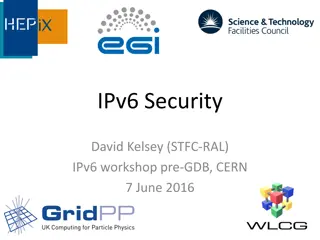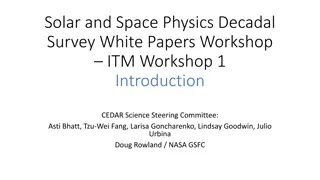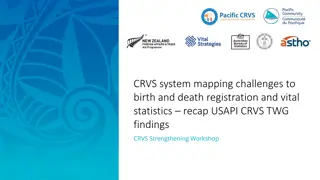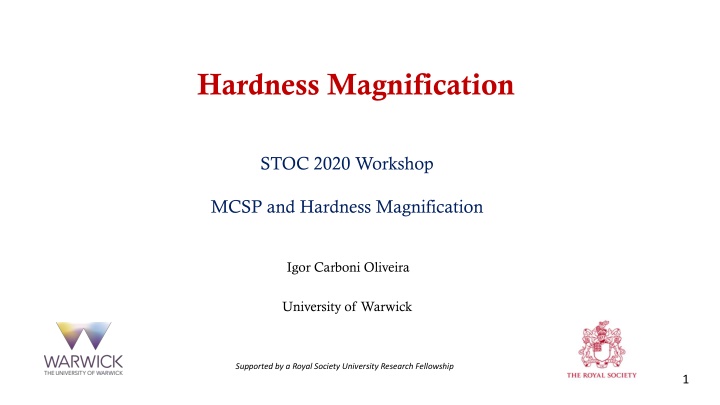
Hardness Magnification in Lower Bound Frontiers
Explore the concept of Hardness Magnification (HM) in computational complexity theory, where weak lower bounds lead to strong lower bounds. Discover recent results and examples showcasing the implications of HM in advancing lower bound research.
Download Presentation

Please find below an Image/Link to download the presentation.
The content on the website is provided AS IS for your information and personal use only. It may not be sold, licensed, or shared on other websites without obtaining consent from the author. If you encounter any issues during the download, it is possible that the publisher has removed the file from their server.
You are allowed to download the files provided on this website for personal or commercial use, subject to the condition that they are used lawfully. All files are the property of their respective owners.
The content on the website is provided AS IS for your information and personal use only. It may not be sold, licensed, or shared on other websites without obtaining consent from the author.
E N D
Presentation Transcript
Hardness Magnification STOC 2020 Workshop MCSP and Hardness Magnification Igor Carboni Oliveira University of Warwick Supported by a Royal Society University Research Fellowship 1
Some current lower bound frontiers: - Super-linear lower bounds against unrestricted Boolean circuits. - Cubic lower bounds against de Morgan formulas. - Super-polynomial lower bounds against depth-2 threshold circuits. Due to well-known barriers, investigating new approaches to LBs is crucial. 3
When minor advances yield major lower bounds Positive/Negative interpretations Research from the last 10 years shows that: - Minor improvements in Algorithms -> Breakthroughs in LBs [Wil 10] Non-trivial SAT algorithms for poly-size formulas -> super-poly formula LBs! - Maybe minor improvements in Lower Bounds -> Breakthroughs in LBs? Yes! More systematic investigation in [AK 10] under the name hardness amplification . almost-linear size TC0 lower bounds for some problems -> super-poly TC0 lower bounds! 4
Hardness Magnification Recent results showing that weak lower bounds imply strong lower bounds. What is new compared to [AK 10] and related works? [AK 10] Required almost-linear size TC0 lower bounds are not known for any explicit problem. Striking aspect of recent developments in HM: Striking aspect of recent developments in HM: Interesting magnification results in settings where we do have lower bounds. 5
Example: Magnification from AC0 lbs Consider the problem of detecting huge cliques on graphs: [Andreev-Jukna 08] Hardness Magnification Phenomenon [CHOPRS 20] 6
Hardness Magnification and Natural Proofs Properties that are constructive, large, useful Magnification applies to specific problems! Unclear how to extract from weak lower bound + magnification a property showing hardness of most Boolean functions. 7
This seems exciting Are we close to getting new lower bounds? 8
HM and String Complexity Unconditional Lower Bounds & Hardness Magnification Does this phenomenon hold for more problems? Can we prove the required lower bounds? 10
Extensions Does this phenomenon hold for more problems? [CMMW 19] and[CJW 19] identified SPARSITY of languages as key property in HM. Weak lower bounds for a SPARSE language in NP -> Breakthroughs in Complexity 11
MCSP and lower bounds against Formula-XOR Can we prove the required lower bounds? Sparsity not an issue in previous LBs: Until recently, only known super-linear LB against Formula-XOR was [Tal 17] for Boolean InnerProductN. Not sparse enough for HM 12
(Simplified) Structure of typical HM proof [CHOPRS 20] Compression Stage Final Construction Extremely efficient way of converting m-bit input instance into NP-subproblems of size t = mo(1)(or even smaller) Under our easiness assumption, subproblems can be solved by small devices of size poly(t) << mo(1) 14
Remarks - Most proofs go beyond compression/kernelization techniques: easiness assumption might be needed at this stage - HM proofs combine insights from algorithms & complexity theory. Missing component is combinatorial lower bound. - Parity gates often quite powerful in low-level efficient constructions: Error-correcting codes and hash functions 15
[CHOPRS20] A locality barrier HM shows that weak lower bounds for some problems imply major complexity lower bounds. Compression Stage Final Construction Extremely efficient way of converting m-bit input instance into NP-subproblems of size t = mo(1)(or even smaller) Under our easiness assumption, subproblems can be solved by small devices of size poly(t) << mo(1) Almost self-defeating: Proof strategy UNCONDITIONALLY shows that same problems admit weak circuits with small fan-in oracles( local oracle computations). 16
Why do lower bound proofs localize? - AC0 and Random restrictions - Polynomial Method 17
Consequences of locality - Simple adaptations of known lower bounds won t work. bounded fan-in Size parameter needed in HM - Reductionsfrom a localizable lower bound won t work. 18
Beyond the locality barrier Locality poses a significant challenge, but it does not capture all instantiations of HM. MrKtP: decide rKt complexity of input string in {0,1}N Interesting to understand techniques in circuit complexity that do not extend to small fan-in oracles. 20
Proof complexity The work of Muller and Pich (2017) in proof complexity inspired several recent HM results. [MP 17] showed that (weak) constant-depth Frege lower boundsfor truth-table tautologies imply super-poly Frege lower bounds. Connected to the program of showing unprovability of circuit lower bounds in Propositional Proof Complexity. Desired LBs are known for Resolution and Res(k), as shown by [Raz 02] and [Razborov 03]. Notion of locality/oracles is unclear & HM is not well understood in Proof Complexity 21
Obstructions and sharp thresholds in HM Again, it is unclear if a locality barrier applies in this setting! 22
Key takeaways - Extending some known LBs by very little -> breakthroughs in complexity. - Locality barrier: most (but not all) LB techniques are not refined enough. - My personal take: HM part of our complexity toolbox & new surprising results within reach. 23
HM references mentioned in this talk: [AK 10] Amplifying lower bounds by means of self-reducibility (JACM 10). [MP 17] Feasibly constructive proofs of succinct weak circuit lower bounds (Annals of Pure and Applied Logic). [OS'18] Hardness magnification for natural problems (FOCS'18). [OPS'19] Hardness magnification near state-of-the-art lower bounds (CCC'19). [CMMW'19] Relations and equivalences between circuit lower bounds and Karp-Lipton theorems (CCC'19). [MMW'19] Weak lower bounds on resource-bounded compression imply strong separations of complexity classes (STOC'19). [O 19a] Randomness and intractability in Kolmogorov complexity (ICALP'19). [O 19b] Advances in Hardness Magnification (Notes/Simons Talk). [CJW'19] Hardness magnification for all sparse languages (FOCS'19). [CHOPRS'20] Beyond natural proofs: hardness magnification and locality (ITCS'20). [KKLMO'20] Algorithms and lower bounds for de Morgan formulas of low-communication leaf gates (CCC 20). [CJW'20] Sharp threshold results in computational complexity (STOC 20). 24


